the place where Paleontology and Paleoanthropology meets Philately
The Netherlands
Fossils and reconstructions of dinosaurs and other prehistoric animals on stamps and postmarks of the Netherlands
| << previous country | back to index | next country >> |
Contents:
- Country overview
- Philately of the Netherlands
- Official stamps of the Netherlands related to Paleontology
- Official stamps of private post companies of the Netherlands related to Paleontology
- Some personalized stamps of the Netherlands related to Paleontology
- Other stamps of the Netherlands to consider
- Commemorative postmarks of the Netherlands related to Paleontology
- Post marks and meter frankings of commercial companies with fossils and prehistoric animals on them
- References
- Acknowledgments
The Netherlands, is the main constituent country of the Kingdom of the Netherlands. It is a small, densely populated country located in Western Europe with three island territories in the Caribbean.
The European part of the Netherlands borders Germany to the east, Belgium to the south, and the North Sea to the northwest, sharing maritime borders with Belgium, the United Kingdom, and Germany.
The largest cities in the Netherlands are Amsterdam, The Hague and Rotterdam. Amsterdam is the country's capital, while The Hague holds the Dutch seat of government and parliament.
The name Holland is also frequently and incorrectly used to refer informally to the whole of the country of the Netherlands. [R1]
The first stamps of the Netherlands were issued in 1852 and depict King William III. During the Second World War the Netherlands were occupied by Germany. Stamp issues continued and a number of semi-postal stamps were issued. [R2]
Official stamps of the Netherlands related to Paleontology: fossils
| 27.04.1962 "International Congress of Museum Experts" (semi-postal) [1] | ||
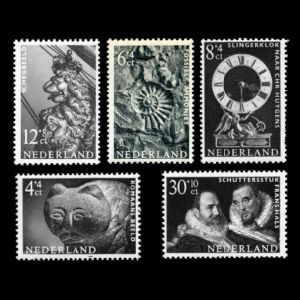 |
|
|
Notes:

|
| Ammonite fossil on semi-postal stamp of Netherlands 1962 - normal and rotated view. MiNr.: 775, Scott: B364 |
When rotated by 180 degree, the stamp shows a different view on the fossil.
By placing two similar stamps one by another, it is possible to get a positive and a negative impression of the fossil.
The image on the left - looks like the external cast.
The image on the right looks like the external mold - both showing the outside of the animal.
Note: the semi-postal means that part of face value of the stamp (4ct in this case) is a donation collected by the post for a good purpose.
There are only few semi-postal Paleontology or Paleoanthropology related stamps.
Official stamps of private post companies of the Netherlands related to Paleontology: dinosaurs and other prehistoric animals
| 1994 "Prehistoric animals" [LN1] | ||
 |
|
|
Notes:
[LN1] In 1994, perhaps influenced by the Jurassic park film (1993), four private city-post companies of the Netherland issued Mini-Sheets with stamps of dinosaurs and other prehistoric animals.
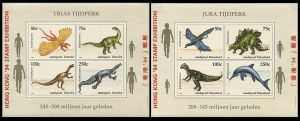 |
| Two of four overprinted Mini-Sheets for the stamps show in Hong Kong 1994. |
- Utrecht local mail (Triassic Era)
- Maasland local mail (Jurassic Era)
- Nijmegen local mail (Early Cretaceous Era)
- Den Haag (The Hague) local mail (Late Cretaceous Era)
These Mini-Sheets exist with overprint of the Hong Kong stamps exhibition 1994.
If you have any postally used cover or postcard with these stamps, please share the scan with the Siteo Admin (600 dpi preferred).
Some personalized stamps of the Netherlands related to Paleontology: fossil and reconstruction of prehistoric animals
The Netherlands allows personalized stamps – several that show paleontological themes are shown below.In addition, the company “Ucollect” produces many personalized stamps in the Netherlands – including many issues that depict dinosaurs, other prehistoric organisms, and prehistoric people.
Ucollect’s stamps are produced with the sole goal of raising money from collectors – and hence are excluded from this website.
| 2008 "150th anniversary of Eugene Dubois" [SP1] | 10.09.2016 "T. rex in town" [SP2] | 20.04.2019 "34th Youth Stamps Collectors Day" [SP3] |
 |
 |
 |
| 20.10.2019 "Mosasaurus hoffmanni" [SP4] | 13.06.2023 "Prehistoric animals (I)" | 26.09.2023 "Prehistoric animals (II)" |
 |
 |
 |
| 14.11.2023 "Prehistoric animals (III)" | 26.03.2024 "Prehistoric animals (IV)" | |
|
|
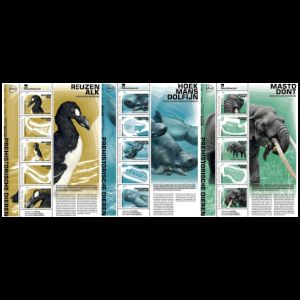 |
 |
Notes:
[SP1] Marie Eugène François Thomas Dubois (1858 – 1940) was a Dutch paleoanthropologist and geologist. He earned worldwide fame for his discovery of Pithecanthropus erectus (later redesignated Homo erectus), or "Java Man". [R5]
The famous fossils are shown on the stamp, which ordered by the German-based philatelic club, “ArGe Bergbau und Geowissenschaften”, as written on the Mini-Sheet margin.

|
| Personalized postcard with Tyrannosaurus rex of Netherland 2016. |
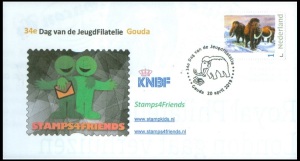
|
| Personalized stamps of Mammoth on commemorative cover of the Netherlands 2019 |
[SP2] In 2016 'Naturalis' museum (full, official name is Naturalis Biodiversity Center) [R3] issued a set of Mini-Sheet with three stamps of Tyrannosaurus rex and three postcards of the same design as the margin of the Mini-Sheet, to commemorate "T rex in town" event that took place between September 10 and June 2017.
As part of this event, the first T rex to go on display in the Netherlands was placed on exhibit in the Museum in Leiden on September 10, 2016.
The story of Tyrannosaurus began in the summer of 2012 when the museum's director,
Edwin van Huis, expressed his ambition to get a Tyrannosaurus.
Researchers of Naturalis went on an expedition in the United States, where almost a year later a fossil
of Tyrannosaurus rex was unearthed out of sandstone in Montana.
With the help of crowd funding, the Naturalis Biodiversity Centre, succeeded in excavating and buying this unique prehistoric
treasure at a cost of EUR 5 million.
The Tyrannosaurus was named "Trix" in honor of former queen Beatrix.
More details are here
[SP3] Personalized stamp with walking group of mammoths at domestic rate, postmark with one of them and commemorative cover issued for the "34thYouth Stamps Collectors Day".
The cover, unfortunately, has nothing in common with mammoths.
[SP4] Personalized stamp and postmark of the similar design issued for "53rd Limburgse Philatelic Day", both show the fossilized skull of Mosasaurus, one of the most famous fossils of the Netherlands.
Other stamps of the Netherlands to consider: fossils on margin of Mini-Sheet
| 01.02.2006 "Beautiful Netherlands: Leiden" [A1] | ||
 |
|
|
Notes:
[A1]
 cThe skeleton of a small theropod dinosaur shown on the margin the bottom side of
the Mini-Sheet.
cThe skeleton of a small theropod dinosaur shown on the margin the bottom side of
the Mini-Sheet. The designer probably included this because 'Naturalis', the national Natural History Museum, is located in Leiden. [R4] |
Commemorative postmarks and meter frankings of the Netherlands related to Paleontology: fossils and reconstructions of dinosaurs and other prehistoric animals
Legend is here| 01.09.1982 "100 years since death of Charles Darwin" [Sp] | 1987-1988[DU] "National Natural History Museum" [Sp] | 1996-1997[DU] "Nationaal Natuurhistorisch Museum (NNM) presents Camarasaurus" [Sp] [PM2] |
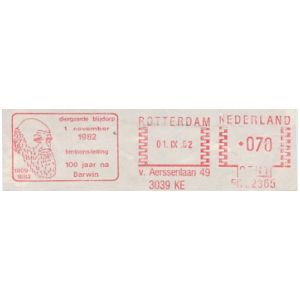 |
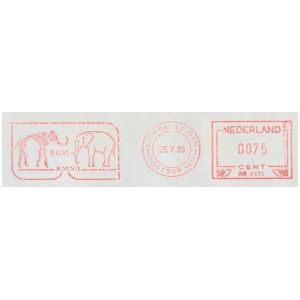 |
 |
| 02.06.2003 "Limburgse Philatelic Day" [Sp] [PM1] | 20.04.2019 "34th Youth Stamps Collectors Day" [Sp] [SP3] | 20.10.2019 "53rd Limburgse Philatelic Day" [Sp] [SP4] |
 |
 |
 |
Notes:
[PM1] Shortly before the show began, fossils of a prehistoric bird were found in a Maastricht Chalk pit of ENCI (Eerste Nederlandse Cement Industrie - First Dutch Cement Industry).
A postmark was created for the event showing a stylized representation of a prehistoric bird by a PostNL designer.
The postmark was ordered by the German-based philatelic club, “ArGe Bergbau und Geowissenschaften”.
[PM2] Nationaal Natuurhistorisch Museum (NNM), which was renamed Naturalis when they moved to their new building a few years after this exhibition.
Post marks and meter frankings of commercial companies with fossils and prehistoric animals on it
Legend is here| 1968 [DU] "Krijt - Papier en Karton" [PM] | 1968 [DU] "Krijt - Papier en Karton" [PM] | 1976 [PM] Sawema" [PM] |

|

| used
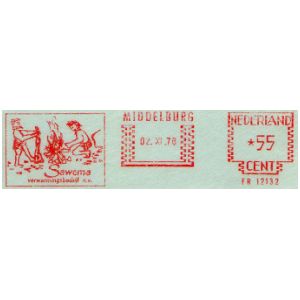
|
| 1971 [DU] "Universal N.V. company from the town Holten" [PM] | 1972 [DU] "Universal N.V. company from the town Holten" [PM] | 1973 [DU] "Universal N.V. company from the town Holten" [PM] |

|
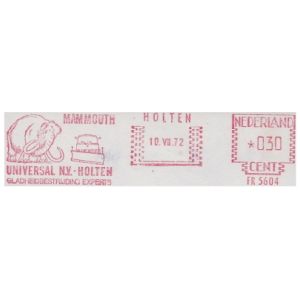
|
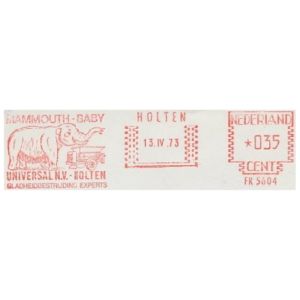
|
| 1999 [DU] "NATO Garnizoen Seedorf" [PM] [PMC1] | ||
 |
|
|
Notes:

|
| Mammoth on coat of arm of Seedorf village in Germany. Image credit: Wikipedia |
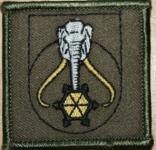
|
| Mammoth skull on coat of arm of NATO base near Seedorf village in Germany. Image credit: "ArmyEmblem.nl" |
Seedorf army station, now in German hands again, was located between Bremen and Hamburg in the state of Lower Saxony, and named after the village of Seedorf just north of the barracks.
In the early 20th century there was a large marl quarry in the municipality near Godenstedt.
The marl was used as fertilizer in agriculture.
Later, in the 1930s, a fossil bone of a woolly mammoth from the Pleistocene was found in the marl quarry.
For this reason, an image of such a mammoth is also present in the village coat of arms.
The spade refers to the former peat mining in the area. [R6]
References:
- [R1] The Netherlands:
Wikipedia,
WikiTravel,
FlagCounter.
- [R2] Postal History and Philately of Netherlands:
Wikipedia,
Links to official website of the Post Authority, stamp catalog and a list of new stamps of Netherlands are here - [R3] Naturalis Biodeversity Center: official website
- [R4] Leiden: stampedout
- [R5] Eugène Dubois: Wikipedia
- [R6] Seedorf: Wikipedia about the NATO camp, Wikipedia about the village, Seedorf municipality (in German).
Acknowledgments:
- Many thanks to fellow collector Jos van den Bosch from the Netherlands, who was the chairman of “Philately Vereniging ’t Fakteurke Klimmen” in 2003, for his help finding information about the postmark from 2003.
- Many thanks to Dr. Peter Voice from Department of Geological and Environmental Sciences, Western Michigan University, for reviewing the draft page and his valuable comments.
| << previous country | back to index | next country >> |